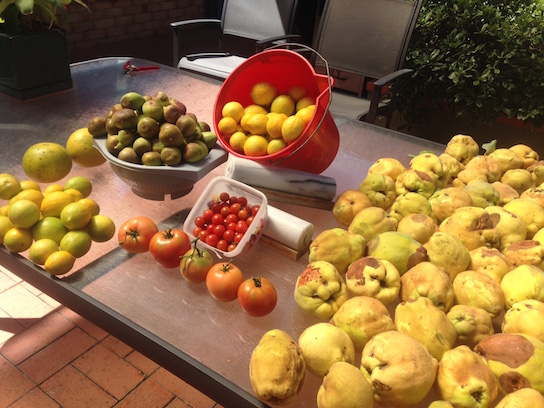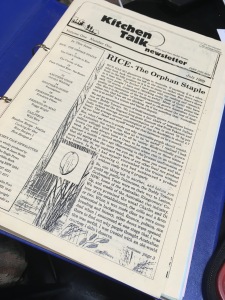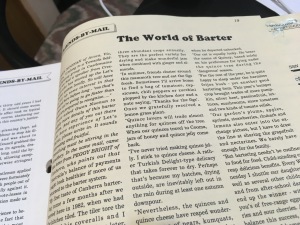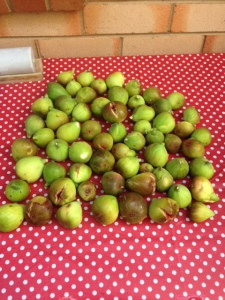The world of barter—go on, give it a try

Our growing season has ended, but it’s starting in the Northern Hemisphere. Time to get your bartering network organised.
A while back, Chloe brought me three wonderful chunks of quince paste that she’d made from fruit gathered from our venerable quince tree.
Quince always take me back to 1982 when I first arrived in Australia. There, in the middle of my new backyard, was a tree I’d never seen before. Turns out it was a quince and I suddenly had the challenge of figuring out how to use the fruit. In an effort to get on top of the abundance this tree delivered, I bought cookbooks only if they had a quince recipe.
About that time, I also enjoyed reading food-related newspaper columns written by Michael Boddy. One of his articles focused on quinces and gave me some local inspiration. I wrote him a letter about my quinces and more.
Imagine my surprise when he included that letter in the ‘Friends by Mail’ column in the first edition (July 1989) of his Kitchen Talk Newsletter. Actually I wasn’t that surprised, because he asked if he could use it.
Just so you know, I haven’t been thinking about that letter all this time. Yesterday, I was dusting one of our many bookcases and came across a ring-binder with all 20 issues of Kitchen Talk Newsletter. So I thumbed through and found the letter.
I decided share it here, because it covers a topic worth thinking about. Here goes.

Ripe figs now cost almost $2 each. Ours are free.
———————————-
Australia’s balance of payment might look healthier if more of us returned to the barter system.
My first taste of Canberra bartering came a few months after we moved here in 1982, when we had the kitchen tiled. The tiler tore the sleeve of his coveralls and I stitched it up. A few days later, when it came time to pay him, he said, ‘Thanks for mending my coveralls. Better knock $10 off the bill’. I was stunned and thrilled. And it didn’t stop there. The tiler’s mum, who lives in Cooma, now gets some of our quinces every year.
Unfortunately, bartering is usually confined to the zucchini and tomato season. Anyone with a glut of fruit searches tirelessly to unload the bounty on others, who also usually have the same glut.

Kitchen Talk Newsletter, very first issue
To make the barter system work effectively, it’s important to widen your circle of friends to include anyone who’s got a glut different from yours. It’s even better if your garden produces some rare delicacy—the things that cost ninety cents each when you can find them at the market. In our corner of Canberra, we’ve combined both tactics with excellent results.
I must confess that our house came equipped with many rare desirables. The fig tree produces three abundant crops annually. They are the perfect variety for drying and make wonderful jam when combined with ginger and almonds.
In summer, friends cluster around this mammoth tree and eat the figs fresh. Sometimes I’ll arrive home to find a bag of tomatoes, capsicums (bell peppers), chilli peppers or zucchini plopped by the kitchen door and a note saying, ‘Thanks for the figs’. Once we gratefully received a lemongrass plant.
Quince lovers will trade almost anything for quinces off the tree. When our quinces travel to Cooma, jars of honey and quince jelly come back.
I’ve never tried making quince jelly. I stick to quince cheese. A rather Turkish Delight-type delicacy that takes forever to dry. Perhaps that’s because my batches, drying outside, are inevitably left out in the rain during at least one unexpected autumn downpour.
Nevertheless, the quinces and quince cheese have reaped wonderful returns of pears, kumquats, pumpkins, Jerusalem artichokes, tomatoes and zucchini.
I’m especially pleased about the Jerusalem artichokes. Never plant them in your own backyard—they’ll overrun the place.
And, by the way, never sit under a quince tree between January and April (Southern Hemisphere). Mature quinces are rather like coconuts, and I remember my husband once quoting some article that said falling coconuts were one of the major causes of death and injury in coconut-growing areas.

My article
We chanced luck this year by having a special luncheon under the quince tree in January. One guest was an ageing Australian literary figure. It was difficult to concentrate on the conversation while I envisaged a front-page newspaper article on this National Treasure being hospitalised after being bonked by a quince.
I willed the quinces to stay on the tree and nearly fainted with relief when he departed unbonked.
Our cat is equally lucky. He bears the name of Quincy, based solely on his preference for lying under the quince tree during the ‘dangerous’ season.
For the rest of the year, he is quite happy to sleep under the harmless feijoa bush—yet another good bartering item. This year’s bumper crops brought trades of more pumpkin, silver beet, passionfruit, lettuces, mushrooms, tomatoes and two kinds of tomato relish.
Our garden’s plums, apples, apricots, strawberries, rhubarb and lemons also enter into the exchange picture, but I have to draw the line at sharing grapefruit and nectarines. We barely have enough for the family.
But bartering needn’t been confined to food for food. Child-minding can reap delicious benefits. Every Wednesday I shuttle our daughters, as well as several other children, to and from after-school dancing. I end up the winner—with thank yous of free-range eggs, raspberries and sour cherries. And to help balance this success, I often send back a jar of homemade mayonnaise.

An abundance of figs
I guess that’s the key to happy, civilised bartering. No one ever really mentions money, or even suggests bartering. It just happens. Someone says, ‘I have this mountain of figs. Would you take some off my hands, please?’ A few weeks later, the happy recipient knows where to get rid of excess pears, or whatever.
A recent advertisement in The Canberra Times tickled me. Someone near Wamboin was advertising free firewood. Apparently there were a number of fallen trees, just waiting to be cut up and carted away. There was a phone number to call for directions and a footnote, which said, more or less, ‘Take as much wood as you like, just leave 10 percent of the take by the homestead’.
What style.
———————————
The pics here are from one of our bumper years. Graeme, who happened to be minding the house and dogs as we travelled, harvested the bounty and let everyone know to collect what they wanted from the picnic table in the backyard.
Over the years, we’ve lost a few bargaining trees. The apricot and apple went during some renovations, and the nectarine keeled over. There’s a replacement peach tree.
P.S. I’m decluttering. Does anyone in Australia want my collection of Kitchen Talk Newsletters? If I need to refer to them again, the National Library holds a full set.

Two sizes of tomatoes on offer. Damage on the quinces (at right) is caused by greedy cockatoos.

I had a friend who lived in the foothills of the Dandenongs. They set up a barter system that seemed to work pretty well for a time. Some good souls tried the same thing in my suburb not long back but it never seemed to achieve critical mass. Nice idea though.
And I remember quince jelly on toast as a kid. So sweet.
LikeLiked by 1 person
So do I need to add you to my quince recipient list?
LikeLiked by 2 people
Very kind, but perhaps you could post my share to the W Whelk. They need sweetening up, I reckon.
LikeLiked by 1 person
Touché, what a great comeback. And you’re right.
LikeLiked by 1 person
That’s very interesting, Peggy. My Dad once gave a neighbour a lot of apples, and in return, he cut our lawn when we were on holiday. But it wasn’t a formal ‘barter’ arrangement. I think this could catch on in a really big way.
Maybe you should create ‘Barterbook’, and become as wealthy as Mark Zuckerberg? 🙂
Best wishes, Pete.
LikeLiked by 4 people
Oh Pete, what a good idea—Barterbook. Worth thinking about, but I’ll be travelling.
LikeLiked by 2 people
It will take off so fast, you can pay someone to run it, Peggy! 🙂
LikeLiked by 1 person
I just laughed out loud.
LikeLiked by 4 people
An excellent advocacy
LikeLiked by 1 person
Thanks Derrick.
LikeLiked by 2 people
The Minneapolis/St Paul metropolitan area is home to some 4 million people and several quadrillion mosquitoes. The borders of the area are defined by the Metropolitan Mosquito Control Zone but most inhabitants hold that the true borders are defined by the Metropolitan Zucchini Control Zone because the plague of squash is more numerous and onerous than that of the mosquitoes.
LikeLiked by 2 people
You’re right, plus the zucchinis are way, way bigger than the mosquitos.
LikeLiked by 2 people
And completely out of control.
LikeLiked by 1 person
We bartered all the kids’ senior pictures for mechanic work. My husband is still working it off. Bless his heart. It is a good system.
LikeLiked by 1 person
It’s a wonderful system!
LikeLiked by 1 person
Quince jelly! 😍
I had to laugh at your “departed unbonked” – those little things look so harmless, but they’re not to be trifled with!
LikeLiked by 3 people
Definitely not to be trifled with! 🙂
LikeLiked by 2 people
One day in Malta we took a walk around Mellieha and on the way back to the hotel stopped at a beach bar for a break. A Looky-Looky man approached and showed us the rubbish that he was hoping to sell. I would never buy from a Looky-Looky man and I told him to go away. He packed up and moved on but my five year old granddaughter called him back.
Sensing a sale he started all over again, she liked a carved elephant and he said it was five euro. my reaction was ‘no way‘, my daughter said ‘offer him four’, Patsy thought about this for a while and then looked him directly in the eye and said ‘Three’. I choked on my beer, Sally almost fell off her chair, the Looky-Looky man just laughed and agreed the deal!
The next time I go to Morocco and go shopping in the Souks or go to buy a new car I am taking my granddaughter with me to do the negotiating…
LikeLiked by 4 people
I think all of us would like to take Patsy along when we go shopping! She’s got style and her wits about her.
LikeLiked by 2 people
It’s a wonder you travel at all with so much fun at home! Your yard must be a lovely walk all by itself. Every year, our neighbor grows the absolute best tomatoes, and I have to be real clever to figure out the repayment (usually salsa.) Fun topic.
LikeLiked by 2 people
The garden is wonderful in spring, summer and autumn, but it’s pretty dreary in winter. Time to travel!
LikeLiked by 3 people
Nice Post thank you Leggy Peggy for sharing this post….
LikeLiked by 1 person
You are most welcome. Thanks for stopping by and for commenting.
LikeLiked by 1 person
You could always scan them! The Newsletters, I mean. My grandparents wived the barter system in the Ozarks. Eggs, beets. What they grew too much of would end up in a jar or a paper bag. exchanged for sweet corn or peaches. More fish than could be cleaned and frozen turned into bags of chicken feed. They had banks. I don’t know how they stayed in business. It was bigger than food. A stack of rescued window glass would turn into an old soda cooler where fresh bait could travel and turn into all sorts of things, including grandkid candy. Unless areal freeloader coms to the party, bartering is such a simple, and yet very complex, higher order social interaction!
What the heck is a quince?
LikeLiked by 3 people
A quince is an apple, a sweet dessert apple 😊
Ciao
Sid
LikeLiked by 1 person
Sounds like your grandparents were totally on top of the bartering system.
Also, quinces are related to apples and pears, but are much more bitter. You can’t eat them raw. I did a recipe using them on my cooking blog. https://cookingonpage32.wordpress.com/2018/03/16/quince-compote/
LikeLiked by 2 people
What a garden, what a story 😀😍
Ciao
Sid
LikeLiked by 3 people
Thanks Sid. I was surprised to find the article. And to think I wrote it 29 years ago.
LikeLiked by 3 people
Never say it’s too late 😄
LikeLiked by 1 person
We only have bay leaves to exchange. Trees full of them and all year around. I’ll gladly barter them for the figs.
Years ago, while running a flower shop in Balmain we tried giving free posies to pensioners on Thursday. When the word got out, in no time there were more pensioners than posies. Boy, could some of them run too. We had to stop the practice.
LikeLiked by 1 person
Amazing how something like that can be taken advantage of. The smart ones would have kept their mouths shut so they didn’t spoil the generosity.
LikeLiked by 1 person
Good morning thanks for sharing!!
LikeLiked by 2 people
Thanks for sharing that explanation.
LikeLiked by 2 people
We’re housesitting now. People drop off veggie peelings and waste which we give to Elvis, the stinky billy goat, and the chickens, and the veggie droper offers get eggs – and sausages when there were pigs. No waste and everyone feels good. I love it!
LikeLiked by 2 people
I love it too, especially the part about no waste.
LikeLiked by 1 person
Loved this piece. Such a Midwestern feel of the shared fruits of backyard labor. 🙂 I need to find the hearty veg that can survive my brown thumb. Rhubarb, maybe? The previous homeowners had a tomato plant overrunning their garden, but Bo hates tomatoes, soooooooooooo that died. We’d love to get a fruit tree, though! Your quince story made me laugh–glad no one’s gotten bonked! xxxxxx
LikeLiked by 2 people
Oh yes, try rhubarb. I forgot to mention we have it in the garden too, along with lots of herbs. I even have a recipe for rhubarb cookies.
LikeLiked by 2 people
Oooo, yum! I just picked up a book on canning, and I’m tempting to experiment at least once with strawberries and rhubarb. 🙂
LikeLiked by 2 people
They are a great combo. Let us know what you make.
LikeLiked by 1 person
All that luscious bounty! I had to laugh at your Jerusalem artichoke warning. I had a plot in a community garden once that had–unknown to me–formerly been planted with them. Rather than removing every root particle, I just chopped them up and left them in the soil thinking they’d add some nice organic matter. Huge mistake. Every bit of root sprouted new plants and I fought them for years.
LikeLiked by 1 person
Oh dear, I shouldn’t laugh. Sorry my warning about Jerusalem artichokes came way too late.
LikeLiked by 1 person
You are honest and that’s good!!!!! Nice weekend
LikeLiked by 1 person
Always right to be honest. 🙂 Nice weekend to you, too.
LikeLike
Wow Peggy, you are so blessed to have such an abundance of home grown produce. Those figs look amazing. And I love how you named your cat Quincey…quite appropriate I’d say! 😉
LikeLiked by 2 people
The cat hung around our backyard (sleeping under the quince tree) for quite a few days before he lost a fight with a possum and came to us for help. Then he became ours.
LikeLiked by 2 people
Great idea for those who can grow things … which is not me! I always have visions of lovingly nurturing a fruit and vegetable bounty such as all these examples, and what I end up with is a dead plant I forgot to water.
LikeLiked by 1 person
I’m not really a gardener. The trees pretty much look after themselves, as do most of the herbs. The tomatoes and keeping the birds out of the figs are my challenges. Some years I win and some years I don’t.
LikeLiked by 3 people
I envy your fig tree. The barter system is great for those who have gardens. People do it around my area, too.
LikeLiked by 1 person
I just hate to see good food (even slightly iffy food) go to waste unnecessarily.
LikeLiked by 1 person
LikeLiked by 1 person
Thanks for that great link about quinces. They are very popular in the Spanish speaking world.
LikeLiked by 1 person
Beautiful share leggypeggy! How nice it was to be published back then. The barter system? No not a bad idea. It has been before and will aid us all again in the very near future
LikeLiked by 1 person
Bartering is a great way to connect with people and save money.
LikeLike
What a wonderful way to live. Folks watching out for other folks. Friendly, neighborly, and I bet a lot of joy and smiles. Wonderful article Peggy. I really enjoyed it. By the way I’m still in the hospital. I’m hoping to get out before summer. I haven’t been home 00 2018 nor for Christmas or Thanksgiving. Looking forward to seeing my room soon
LikeLiked by 1 person
Oh Nancy, bless your heart. So sorry you have had so much time in hospital. Hope you manage to ‘escape’ soon!
LikeLike
A truly feel good post Peggy. I felt like I was walking through the 1950s. Prolific zucchini’s – have you read, Animal, Vegatable, Miracle? I read it around 3 years ago, and little things in life bring it to mind all the time. In the case of your post it was prolific zucchini’s. It’s a great book.
LikeLiked by 1 person
Thanks so much for the book recommendation. Will check it out.
LikeLiked by 1 person
I’m slightly jealous that you have quince. They were common when I was a child in the U.S., but they seem to be rare today. There are lots of quince recipes in old cookbooks, but I have not been able to find any quince to actually try making any of them. Maybe I’ll get lucky next fall and find some.
LikeLiked by 1 person
Oh Sheryl, I’m so sorry you can’t find quince near you. It does confirm why I’d never seen it or heard of it when growing up in the USA. Check with any nearby orchards. They may have a tree or two, but not enough to display and sell to the public. I head to the USA today and will ask around on my travels.
LikeLike
SOOOO Irritating when the computer trolls kidnap my comment! Second try:
I’ve never had a quince and have no idea what they taste like. Not available here in Southern California nor are fresh figs. Years ago my parents grew a magnificent fig tree in their
“Big House” and I tried to make fig newtons. Couldn’t find a recipe and it was pre-Internet so I made a batch of what was more like a fig bar. Two layers of a kinda oat shortbread with a fig and honey paste spread between. Tasty but not a newton.
I can’t grow a thing in my yard – soil is like concrete and it’s poisoned by eucalyptus oil. The tomatoes I grew once were robbed by rats and raccoons before they ripened. It’s the grocery store for me. But I love your bartering idea. I’m willing to trade eucalyptus leaves for anything.
Where did you live before Australia?
LikeLiked by 1 person
Sorry you’ve had such a battle growing things. I grew up in Nebraska, and lived in the Middle
East and Southeast Asia before settling in Australia.
LikeLiked by 1 person
I haven’t had quince since my Nana made quince jam in the 1970s. Was it a colonial import? I barter all the time. One friend makes jams, I make soaps, another makes cookies. We had a bountiful but unwanted guava tree in our garden in Cairo (the fruit bats loved them) but I did take an overhanging Mango from my neighbor…that’s not stealing is it? 😁
LikeLiked by 1 person
Quince is an old fruit and quite popular in the Latin world. It comes from southwest Asia, Eastern Europe and parts of the Middle East. As for the mango, if it hangs in your yard, it’s yours.
LikeLiked by 1 person
I adore mangoes (especially the little yellow ones from Mexico) and now I remember quince in Middle-Eastern recipes.
LikeLiked by 1 person